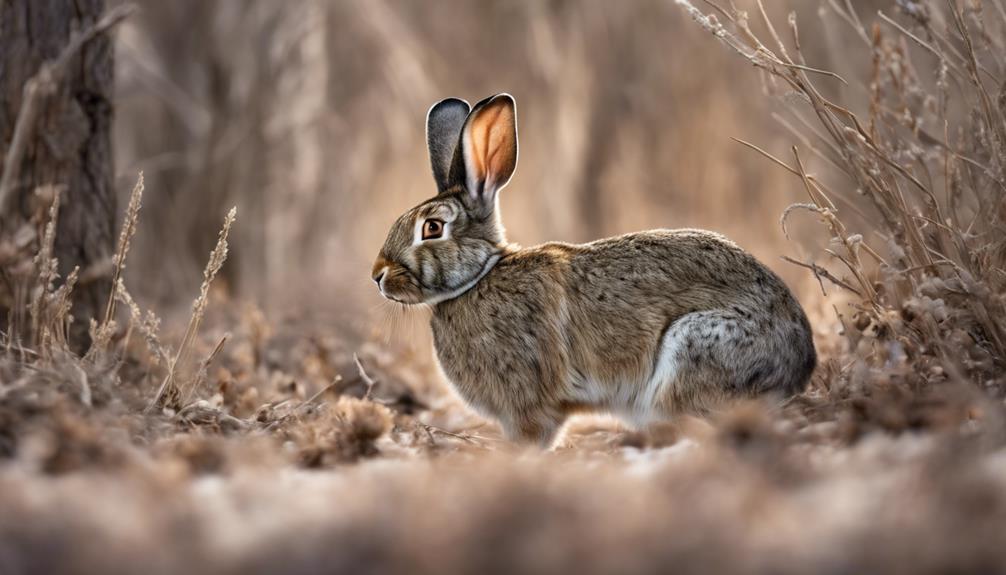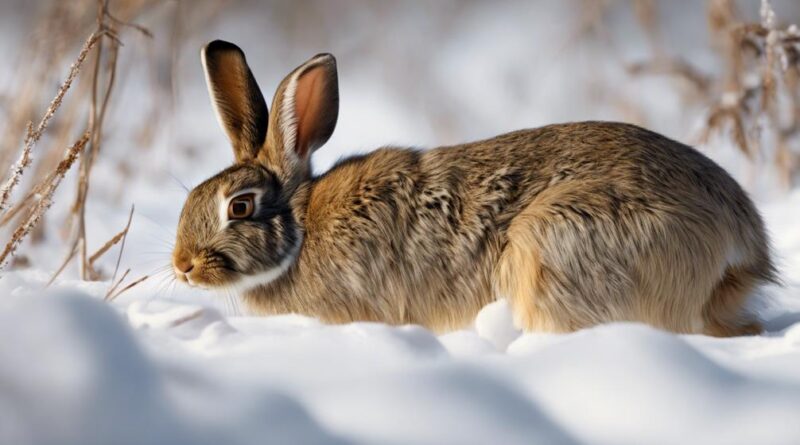Adaptation Strategies of Wild Rabbits Explained
Wild rabbits have evolved remarkable adaptations for survival. They construct intricate burrow systems with multiple entrances for temperature regulation. Their camouflage methods include color matching and freezing to avoid detection. Socially, they communicate to warn of predators and divide protective roles. Reproductively, they have rapid mating cycles and unique birthing abilities. Dietary habits involve selective feeding and cecotrope consumption for nutrients. Burrows offer safety, utilizing scent markings for protection. Seasonally, rabbits migrate for foraging and hibernate to conserve energy. Their strategies showcase their resilience in challenging environments. Discover more about their fascinating adaptations.
Physical Adaptations for Survival
Wild rabbits have developed various physical adaptations to enhance their survival in their natural habitats. One key adaptation is their adeptness at burrow construction. Rabbits excavate elaborate burrow systems consisting of interconnected tunnels that provide shelter from predators and the harsh elements. These burrows often have multiple entrances and exits, enabling quick escapes if necessary. The intricate design of these burrows also helps regulate temperature and humidity, creating a comfortable microclimate for the rabbits.
Another crucial physical adaptation of wild rabbits is their ability for evasive running. When faced with a threat, rabbits exhibit remarkable agility and speed, allowing them to swiftly zigzag through their environment to evade predators. Their powerful hind legs propel them forward, while their lightweight bodies make them swift and nimble. This evasive running behavior is a result of both genetic adaptations and learned behaviors, honed through generations of survival in the wild.
Camouflage Techniques in the Wild
In their natural habitats, rabbits employ sophisticated camouflage techniques to blend seamlessly into their surroundings, enhancing their chances of survival. Blending tactics play a crucial role in the rabbit's ability to evade predators. One of the primary strategies rabbits use is color matching. Their fur color often mimics the shades of the environment they inhabit, such as brown or grey tones that help them merge with the soil or rocks. This color adaptation provides effective concealment against predators that rely on sight for hunting.
Moreover, rabbits exhibit disruptive coloration, where patterns on their fur break up their body outline. This technique makes it harder for predators to distinguish the rabbit from the background, further enhancing their camouflage. In addition to coloration, rabbits utilize their environment for concealment. They often seek refuge in dense vegetation, burrows, or underbrush, where their natural coloring and patterns can effectively mask their presence.
Furthermore, rabbits display behavioral adaptations that aid in their camouflage. They freeze when they sense danger, relying on their ability to remain motionless to avoid detection. This behavior, combined with their physical camouflage, significantly increases their chances of survival in the wild. Overall, the intricate blending tactics and concealment methods of wild rabbits exemplify the remarkable adaptations these animals have evolved for survival.
Social Behavior for Protection
Social interactions among rabbits play a crucial role in enhancing their collective protection against potential threats in the wild. Predator recognition is a key aspect of social behavior in rabbits. Through group dynamics, rabbits communicate and alert each other about the presence of predators, increasing the overall awareness level within the group. This communication helps in early predator detection, giving the rabbits more time to flee or seek shelter.
In group dynamics, rabbits often display altruistic behaviors towards one another. For example, some individuals may take on sentinel roles, keeping watch for predators while the others feed or rest. This division of labor within the group increases the overall protection level, as there are always vigilant individuals scanning the surroundings for potential threats.
Moreover, group living provides rabbits with the advantage of diluting individual risk. By being part of a group, each rabbit benefits from the collective vigilance and predator detection efforts of the whole group. This shared responsibility enhances the overall safety of the community, as potential predators are more likely to be detected by multiple individuals within the group.
Reproductive Strategies in Nature
Utilizing a variety of reproductive strategies is crucial for the survival and proliferation of rabbit populations in their natural habitats. Wild rabbits exhibit specific mating rituals and breeding habits that are finely tuned to ensure the continuation of their species.
Mating rituals among wild rabbits are often characterized by intricate behaviors aimed at attracting suitable mates. Male rabbits, known as bucks, engage in displays of dominance and aggression to establish territory and court females, called does. These rituals involve activities such as thumping their hind legs, making soft clucking noises, and even jumping in the air in a behavior known as 'binkying' to impress potential partners.
Breeding habits among wild rabbits are closely linked to their reproductive success. Female rabbits have the ability to conceive shortly after giving birth, a phenomenon referred to as superfetation. This unique trait allows them to maintain a continuous cycle of reproduction, ensuring a steady population growth. Additionally, female rabbits are induced ovulators, meaning they release eggs in response to mating, increasing the chances of successful fertilization.
Dietary Adaptations for Nutrition
Wild rabbits have evolved specific dietary adaptations to ensure optimal nutrition intake in their natural environments, reflecting their adaptability to varying food sources and availability. These adaptations are crucial for their survival in the wild.
Foraging habits play a significant role in the dietary adaptations of wild rabbits. They're herbivores, primarily consuming grasses, clover, and other green plants. Their foraging behavior includes selective feeding, where they choose the most nutritious parts of plants, such as young shoots and leaves, to meet their dietary requirements. This selective feeding behavior helps wild rabbits maximize their nutrient intake from the available vegetation.
Wild rabbits also have digestive system adaptations that aid in their nutrition intake. They've a hindgut fermentation system, where the cecum plays a vital role in breaking down fibrous plant material. The cecotropes produced through this fermentation process are then reingested by the rabbits to extract additional nutrients that weren't absorbed during the initial digestion. This process allows wild rabbits to extract maximum nutrition from their plant-based diet.
Sheltering Tactics in Various Habitats
In their diverse habitats, rabbits employ a range of sheltering tactics to ensure safety and protection from predators and environmental conditions. One key sheltering tactic utilized by rabbits is burrow construction. These burrows serve as vital shelters where rabbits seek refuge from predators and harsh weather conditions. The design of these burrows is strategically planned to include multiple entrances and exits, allowing for quick escapes if needed. Additionally, rabbits exhibit habitat selection when choosing where to construct their burrows, often opting for areas with dense vegetation or near water sources for added protection and resources.
Camouflage tactics are another important sheltering strategy employed by rabbits. Their fur coloration and patterns often blend seamlessly with their surroundings, providing them with a natural form of protection by making it harder for predators to spot them. This camouflage adaptation allows rabbits to remain hidden while they rest or seek shelter in vegetation, further enhancing their survival chances in the wild.
Predation Avoidance Mechanisms

To enhance their survival in the wild, rabbits have developed intricate predation avoidance mechanisms that are crucial for their protection against predators. One of the key strategies employed by wild rabbits is burrow construction. Rabbits are known for their exceptional digging abilities, allowing them to create elaborate underground burrow systems. These burrows serve as safe havens where rabbits can retreat to when threatened by predators. The complex network of tunnels not only provides protection but also offers escape routes, making it difficult for predators to reach the rabbits.
In addition to burrow construction, rabbits utilize scent marking as a predation avoidance mechanism. By secreting scent from glands located under their chins, rabbits mark their territory to communicate dominance and warn off potential predators. This olfactory communication helps rabbits establish boundaries and reduce the likelihood of encountering predators in their vicinity. Moreover, scent marking can also signal reproductive readiness, further contributing to the survival of the species.
Seasonal Adaptations and Migration
Rabbits adapt to changing seasons by altering their behaviors and physiology in response to environmental cues. Seasonal migration is a prominent adaptation observed in wild rabbits, especially in colder climates. As winter approaches and food becomes scarce, rabbits may migrate to regions with more abundant resources. This migration behavior allows them to survive harsh winters by seeking out areas with better foraging opportunities.
Moreover, hibernation patterns play a crucial role in the seasonal adaptations of wild rabbits. In regions where temperatures drop significantly, some rabbit species enter a state of hibernation to conserve energy and maintain body temperature. During hibernation, their metabolic rate decreases, allowing them to survive for extended periods without needing to actively forage for food.
It is essential to note that not all rabbit species exhibit the same seasonal adaptations. For instance, rabbits living in milder climates may not engage in long-distance migration or hibernation but instead adjust their behaviors based on local environmental conditions. By understanding these seasonal adaptations and migration patterns, researchers can gain valuable insights into how wild rabbits cope with changing seasons and ensure their survival in diverse habitats.
Frequently Asked Questions
How Do Wild Rabbits Communicate With Each Other in the Wild?
In the wild, wild rabbits communicate through a variety of methods. Vocal signals, such as soft grunts or high-pitched squeals, help convey emotions and warnings to each other. They also use scent marking to leave messages for other rabbits.
Additionally, body language plays a crucial role in their communication, with behaviors like thumping indicating danger. By combining vocalizations, scents, and body movements, wild rabbits effectively convey information within their social groups.
What Are the Common Diseases That Affect Wild Rabbit Populations?
When it comes to diseases affecting wild rabbit populations, disease prevention is crucial. Immune responses play a vital role in combating parasitic infections and viral outbreaks that can decimate rabbit communities.
Understanding the mechanisms behind these immune responses and implementing strategies for disease prevention are key in maintaining healthy wild rabbit populations. By studying common diseases and their impact, researchers can develop effective measures to safeguard these animals from potential health threats.
Can Wild Rabbits Distinguish Between Different Predators?
When it comes to predator recognition, wild rabbits display impressive survival instincts. They can distinguish between different predators through various cues like scent, sound, and visual characteristics.
This ability helps them adapt to their environment and communicate effectively with other rabbits about potential threats. By honing their predator recognition skills, wild rabbits increase their chances of survival in the face of danger.
Do Wild Rabbits Exhibit Territorial Behavior?
Wild rabbits exhibit territorial behavior as part of their survival strategy. This behavior is closely linked to their nesting habits and social hierarchy. Rabbits establish territories to protect their nests and ensure access to resources like food and mates.
Within these territories, rabbits establish a social hierarchy to determine dominance and access to the best resources. Understanding these behaviors is crucial for comprehending the complex social dynamics of wild rabbit populations.
How Do Wild Rabbits Cope With Environmental Changes Caused by Human Activities?
When human activities alter the environment, wild rabbits employ behavioral adaptations and survival mechanisms to cope. These include changes in foraging patterns, nesting behaviors, and increased vigilance.
Conclusion
In conclusion, wild rabbits demonstrate a variety of adaptation strategies to survive in their natural habitats. From physical characteristics like camouflage and sheltering tactics to social behavior and reproductive strategies, these animals have evolved to thrive in diverse environments.
By understanding these adaptations, researchers can gain valuable insights into the intricate balance between prey and predator dynamics in the wild. Further studies on seasonal adaptations and migration patterns will continue to shed light on the resilience of wild rabbit populations.
